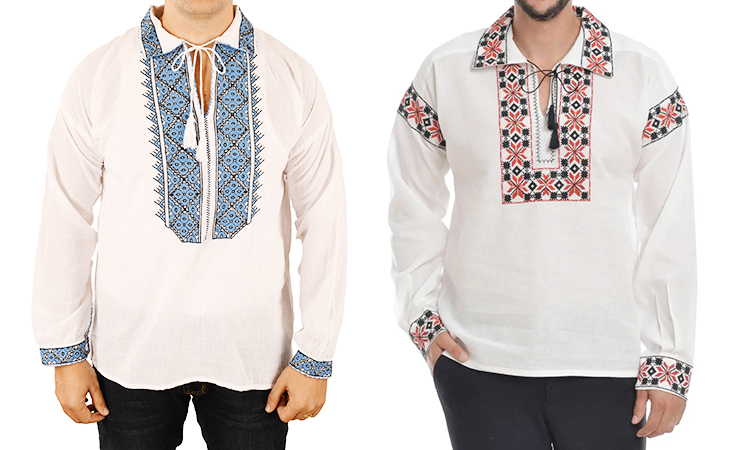
Romanian clothing, deeply rooted in tradition, reflects the country’s diverse cultural and regional influences. Traditional garments for both men and women are notable for their rich embroidery, natural materials, and symbolic designs. Each piece holds historical significance, providing insight into Romania’s rich cultural heritage.
Romanian Men’s Clothing
Ia Românească (Romanian Shirt)
The men’s shirt, or “ia,” is a cornerstone of traditional Romanian attire. Typically made from white linen or cotton, it features intricate embroidery on the chest, cuffs, and collar. These embroidered patterns vary by region, often symbolizing natural elements like the sun or stars. The ia is a versatile garment, worn for both everyday activities and special occasions.
Bundă (Sheepskin Coat)
The bundă is a fur-lined sheepskin coat that provides warmth in Romania’s colder regions, especially in winter. Decorated with traditional embroidery in contrasting colors like red or black, it is as functional as it is decorative. Historically, it was a symbol of wealth and status, with the finest coats passed down through generations. Today, it remains a cherished piece of traditional clothing in rural areas.
Ițari (Woolen Trousers)
Ițari are narrow woolen trousers designed for warmth during Romania’s cold seasons. They are typically white or grey and are commonly worn tucked into leather boots. Though simple in design, their durability and warmth made them a staple in Romanian men’s wardrobes. Ițari are often worn with a wide belt to complete the traditional look.
Opinci (Traditional Leather Shoes)
Opinci are traditional Romanian shoes made from a single piece of leather and secured with laces around the ankle. These shoes were practical for traversing the rugged, rural landscapes of Romania. Their simple yet durable design made them a popular choice for peasants. Even today, opinci remain a symbol of Romania’s agrarian roots.
Chimir (Wide Belt)
The chimir is a wide leather belt, often adorned with decorative stitching or metal embellishments. Historically, it was worn for both practical and decorative purposes, helping to secure tools or weapons at the waist. Chimir belts are often a key component of festive or ceremonial attire. The belt’s size and detailing frequently signified the wearer’s social status.
Romanian Women’s Clothing
Ie (Embroidered Blouse)
The “ie” is the quintessential piece of Romanian women’s clothing, known for its delicate embroidery. Made from lightweight fabrics like cotton or linen, the blouse features intricate patterns in bold colors around the neckline and sleeves. The embroidery often tells a story, with motifs symbolizing nature, fertility, or protection. Worn both casually and for formal events, the ie is a timeless symbol of Romanian culture.
Catrința (Woolen Skirt)
The catrința is a wrap-around woolen skirt, typically worn over a white underskirt. The fabric is often adorned with colorful embroidery or stripes, depending on the region. Tied at the waist with a cord, the catrința was once an everyday garment but is now mostly worn for festivals or special occasions. Its heavy, durable fabric made it ideal for Romania’s harsh winters.
Bundiță (Sheepskin Vest)
The bundiță is a sleeveless vest made from sheepskin, often worn over the ie blouse. It features richly embroidered details and sometimes includes fur trim for extra warmth. This vest was traditionally worn in Romania’s rural regions, particularly during the colder months. Today, it continues to be a part of ceremonial dress, symbolizing the rugged yet beautiful Romanian countryside.
Maramă (Headscarf)
The maramă is a delicate, often silk or wool, scarf worn by Romanian women to cover their hair. Traditionally, it was an important accessory, with designs that signified marital status or regional origin. The scarf is typically tied at the back of the head, with its long ends flowing down the shoulders. Maramă scarves are still worn today, especially during religious ceremonies or cultural events.
Opreg (Decorative Apron)
The opreg is a decorative apron worn over the catrința, especially during special events. Made from thick fabric, it is embellished with vibrant embroidery, sequins, and sometimes metallic threads. The opreg was historically worn as a sign of fertility and prosperity. It remains a key element in traditional Romanian women’s outfits for festive and religious occasions.
Modern Romanian Clothing
In modern Romania, most people wear contemporary Western-style clothing, with a strong preference for casual and comfortable fashion. However, many Romanian designers are integrating traditional elements like embroidery and folk patterns into modern styles, creating a blend of the old and new. This fusion honors Romania’s cultural heritage while embracing current global fashion trends.
The post Complete Guide to Romanian Clothing appeared first on The Fashiongton Post.
